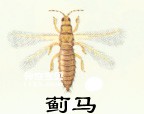[Economic Significance] Because many species of insects of this order often inhabit the flowers of large thistles, small thistles and other plants, they are named thrips. They are small, agile, capable of flying and jumping. They mostly live in plant flowers to feed on pollen and nectar, or live on the tender shoots, leaves and fruits of plants, becoming a pest to crops, flowers and fruits. There are also many species of thrips that inhabit under the bark and litter of forest trees, or in the rhizosphere of grass, feeding on fungal spores, mycelium or humus. In addition, there are a few that prey on aphids, whiteflies, scale insects, mites, etc., becoming natural enemies of pests.

[Identification points] The body length is generally 0.5-7 mm, and there are a few species that can reach 8-10 mm. The body is slender and flat, or cylindrical; the color is yellowish brown, pale or black, and some nymphs are red. Winged species have 2-3 ocelli, while wingless species have no ocelli. The mouthparts are rasp-sucking, and the maxillary stylet is mostly asymmetrical. The wings are long and narrow, with many long and neat tassel-like hairs on the edges. There is a retractable terminal vesicle at the end of the tarsal segment.
[Species and Distribution] About 6,000 species are known in the world and are widely distributed. 336 species have been recorded in my country.
① Tubulifera: The main characteristic is that the end of the abdomen (the 10th abdominal segment) is in the shape of a round tube, called the "caudal tube". Females have no ovipositor. Winged or wingless, the winged type has similar front and rear wings, the wing veins disappear, and there are no micro hairs on the wing surface.
② Terebrantia: The female has a saw-shaped ovipositor and the end of the abdomen is conical. The male's abdomen is broad and rounded at the end. They usually have wings, with large forewings and well-developed wing veins, with at least the front edge vein and one longitudinal vein extending to the top of the wing. There are micro hairs on the wing surface.
The characteristics of this order can be summarized as follows: Thysanoptera of the thrips family, with small and slender bodies and often turned-up abdomen; short horns, converging eyes and crooked mouthparts, and tassels around the wings with bubble feet.
animal tags: Insects Thrips Thysanoptera
We created this article in conjunction with AI technology, then made sure it was fact-checked and edited by a Animals Top editor.